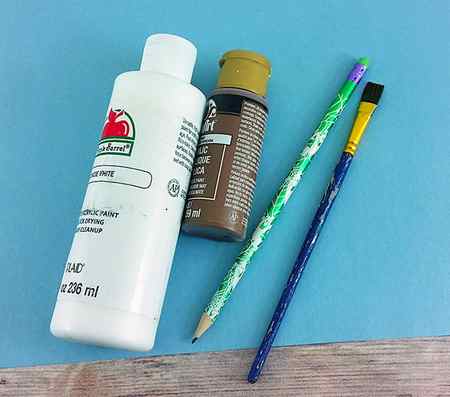Watercolor pencils are water soluble so they’ll dissolve when you paint over them. Avoid the dark watercolor pencils because they will contaminate your paint as you paint over the lines. I recommend using lighter colors so that this isn’t a problem. Light grays seem to work well on white canvases.
The Best Pencil for Drawing on Canvas

Creating a preliminary drawing on canvas will save you time and frustration because you can work out the mistakes before you begin painting. There’s a wide variety of drawing pencils that you can use to sketch on canvas, but it takes some experimenting to discover which ones work best. Fortunately, I have conducted my own tests so you don’t have to.
What’s the best pencil for sketching on canvas? If you prefer drawing with graphite, then I recommend using a 4H or 6H drawing pencil because the graphite is harder so that it shouldn’t smear very much. For drawing on gray or dark canvases, I recommend using a white watercolor pencil so the lines are more visible. Finally, acrylic paint markers are well suited for drawing on canvas. They’re archival, and you can paint over them with acrylics or oils when they’re dry.

All links to Blick Art Materials are affiliate links. This means if you click on it and make a purchase, I earn a commission at no cost to you.
Table of Contents
Testing Drawing Pencils on Canvas

You can buy individual drawing pencils in a variety of hardnesses. The Prismacolor Turquoise drawing pencils are popular, as are the Blick drawing pencils.


Prismacolor Turquoise Drawing Pencils
from: Blick Art Materials
Erasing Pencil on a Canvas
You can use a kneaded eraser to erase pencil lines from a canvas that has been primed with gesso but it’s likely that some of the lines will still be visible. How well it erases depends upon the the hardness of the graphite and how rough the canvas is.
There are other erasers available that are more aggressive, but you have to be careful because they contain abrasives that may scuff the canvas.
I was able to erase most of the lines on my test canvas shown as shown above. The store bought canvases are usually smoother than a canvas that I would prepare myself, so the lines are easier to erase.
All of the pencils left some traces on the canvas but the 3B and 6B pencils are the most difficult to erase.
Use a watercolor pencil if you need to be able to completely erase the lines. You can use a damp rag or sponge to erase it without leaving a trace. One characteristic of watercolor pencil is the color seems to intensify when you apply water to it, so I don’t recommend the brighter colors because they’ll contaminate your colors as you paint over them.
Pencil Smudge Test
In the second column of my test, I tried smudging each line with my finger. All of the pencils smear to some extent, but once again the softer leads were the worst.
One of the problems of drawing on primed canvas is that softer leads have a tendency to smear. The graphite can smear from resting your hand on the canvas and moving it around as you draw. You can place a sheet of paper under your hand to protect the lines, but it can also smear when you paint over the lines with a brush. The graphite may also tint lighter colors as you paint over them.
A regular #2 pencil is equivalent to an HB pencil and I find these are a little too soft for drawing on canvas. The dark lines they produce can be appealing but it seems to smudge more on canvas then it does on paper. I think this is because the paper has more tooth (definition of tooth) that holds the graphite in place. Therefore, I recommend drawing with at least a 4H pencil because it doesn’t smear as much.
I often use acrylics in a manner similar to watercolors. I thin them with water and create loose washes of color on canvas. Many watercolorists allow the pencil lines to show in the final painting. To create this effect with acrylics on canvas, try using a at least a 4H pencil for the drawing. The graphite is harder as the number increases. You can paint over the lines with transparent acrylics and have them show through in the final painting.
Using Acrylic Matte Medium as a Drawing Fixative
One way to prevent drawings from smearing is to use a fixative. You can buying drawing fixative in a spray can and apply it to the sketch to prevent it from smudging. If you decide to use them, be sure to follow the instructions on the can and use adequate ventilation. Make sure the fixative is compatible with your painting medium.
Another thing to consider is that the spray fixative may alter the surface of the canvas. Gesso is slightly absorbent and I would assume that a fixative may make it less absorbent. Spray fixatives also change the look of a drawing. For instance, it’s common for the values may darken after you spray it.
If you’re just working on a preliminary drawing that you’re going to paint over, then you can use acrylic matte medium (link to blick) as a fixative . Since you’re painting over it, it doesn’t matter if you get a little bit of smearing. You really just need the basic line drawing to remain intact. Acrylic medium works well for this purpose.
It’s best to use use a soft brush to reduce the possibility of smearing the graphite. A brush with stiff bristles will dislodge the graphite more than a brush with soft and flexible bristles. I also diluted the matte medium with water so it’s easier to brush on. The test that I feature at the top of this post shows the amount of smearing that each lead created. The softer the lead, the more it smears. 6H and 4H pencils seem to work the best.
The watercolor pencil doesn’t work well at all with this technique because it’s water soluble. It smeared even more than even the softest graphite.
You can paint over it with oils or acrylics when the acrylic medium is dry. Most modern gesso is acrylic based and it’s acceptable practice to paint over it with oils. Oil based grounds are rare, but if you use them then you shouldn’t use acrylic based fixatives over them. The canvases that you buy from the store should state what kind of gesso they use. The majority of them use acrylic gesso.
Drawing on Different Canvas Textures
The canvas that I use in the test is one that I bought from the store. The gesso has a smooth finish so it makes it easier to erase the lines. I think it may have allowed the pencil lines to smear a little easier than a rough canvas.
If you stretch your own canvases, you may find that the texture of the canvas is somewhat rougher. There are a few reasons for this. Artist quality gesso can be a little more absorbent and rough than what manufacturers use on their primed canvases. Also, canvas is available in a wide variety of textures, some of which are very coarse.
Rough canvases are more difficult to draw on with a regular mechanical pencil. The fine point may “catch” on the texture of the canvas and cause it to break. If the canvas is really rough it may lead to a “scratchy” drawing experience, especially if the point of the pencil is sharp.
If this is a problem then select a canvas that has a finer texture. Another tip is to draw with a pencil that has a dull point. A rounded tip won’t catch as much on the canvas.
Lead holders are another option because they have thicker leads than regular mechanical pencils.
What to sketch on a dark canvas
Roll over image to zoom in Click on image to zoom
Description
This black canvas is made with natural, unbleached medium-weight 100% cotton duck stretched around kiln-dried stretcher bars and held in place with a flexible spline, allowing for painting on all four edges as well as the canvas surface. The surface is primed with acid-free black acrylic gesso, providing a dark rich background for traditional paints and techniques as well as paint markers, spray paint and multi-media techniques. Art Alternatives’ black canvases feature a regular 3/4″ deep profile.
View more


